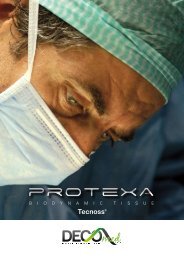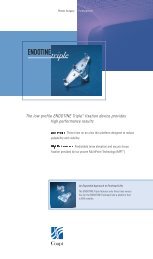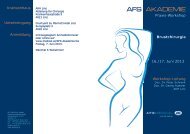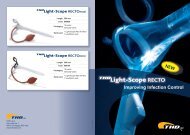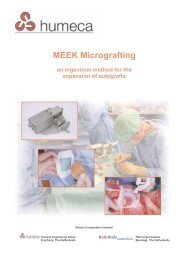Brochure MEEK Micrografting - Humeca
Brochure MEEK Micrografting - Humeca
Brochure MEEK Micrografting - Humeca
Create successful ePaper yourself
Turn your PDF publications into a flip-book with our unique Google optimized e-Paper software.
A 42x42 mm (1.65x1.65")<br />
cork plate...<br />
is covered with a piece of<br />
split skin autograft<br />
Also small graft pieces<br />
can be used<br />
The graft is cut into 196<br />
3x3 mm squares<br />
meek surgery<br />
After the epidermal side of graft is sprayed with an<br />
adhesive, the graft is transferred to a prefolded gauze<br />
At operation wounds to be grafted<br />
are excised down to the underlying<br />
fascia and haemostasis is secured.<br />
A square piece of cork measuring<br />
42x42 mm (1.65x1.65") with<br />
thickness 2.5 mm (0.1") is covered<br />
with a split skin autograft, dermal<br />
size down. Smaller graft remnants<br />
are also suitable by placing them<br />
on the cork plate like a ‘puzzle’.<br />
The cork, covered with graft, is<br />
then placed in a special <strong>MEEK</strong><br />
cutting machine.<br />
The machine contains 13 parallel<br />
circular blades. The cork plate with<br />
the graft on it is passed through the<br />
machine, where the rotating blades<br />
cut through the graft, but not through<br />
the cork. Thus the graft is cut into 14<br />
stripes, 3 mm (0.12") wide. After the<br />
first pass, the cork is rotated 90° and<br />
passed through the machine once<br />
more, thus cutting the graft into<br />
14x14 = 196 square pieces<br />
measuring 3x3 mm (0.12x0.12").<br />
The upper (epidermal) surface of the<br />
graft is then sprayed with an adhesive<br />
dressing spray and allowed to dry<br />
and become tacky. The cork plate,<br />
covered with graft and adhesive<br />
is then pressed onto a prefolded<br />
polyamide gauze, which is folded on<br />
an aluminium foil backing into<br />
14x14 square pleats, the size of<br />
which corresponds to the size of<br />
the cuts in the graft. Then the cork<br />
is gently removed, leaving the graft<br />
islands adhering to the gauze. The<br />
gauze is pulled out by firm traction<br />
on all four sides, until the pleats<br />
become completely unfolded. Finally<br />
the aluminium backing is peeled off,<br />
to leave the expanded gauze with the<br />
separated adherent autograft islands<br />
ready for transplantation.<br />
After trimming the margins, or folding<br />
them double down, the gauze is<br />
applied, graft side down, to the<br />
wound bed and secured with surgical<br />
staples. After about 6 days the grafts<br />
have grown sufficiently into the<br />
wound bed to allow removal of the<br />
gauze, leaving the autograft islands in<br />
situ on the wound. The grafts are then<br />
covered with a non-adherent sheeting<br />
to prevent any movement during daily<br />
dressing changes. After a further<br />
5-6 days the sheeting is removed.<br />
Daily dressings are continued until<br />
epithelialization is complete.<br />
Only in cases of a large expansion<br />
factor (1:9), it is recommended<br />
to cover the <strong>MEEK</strong> grafts with an<br />
overlay of allografts, meshed 1:1.5<br />
(a procedure called ‘sandwich<br />
grafting’). At lower expansions ratio,<br />
the use of allografts is not necessary.<br />
Alternatively cultured autologous<br />
keratinocytes can be applied to<br />
accelerate wound closure at large<br />
expansions.<br />
Expansion is realized by unfolding the gauze,<br />
first in one direction...<br />
... and then in the other direction<br />
4





